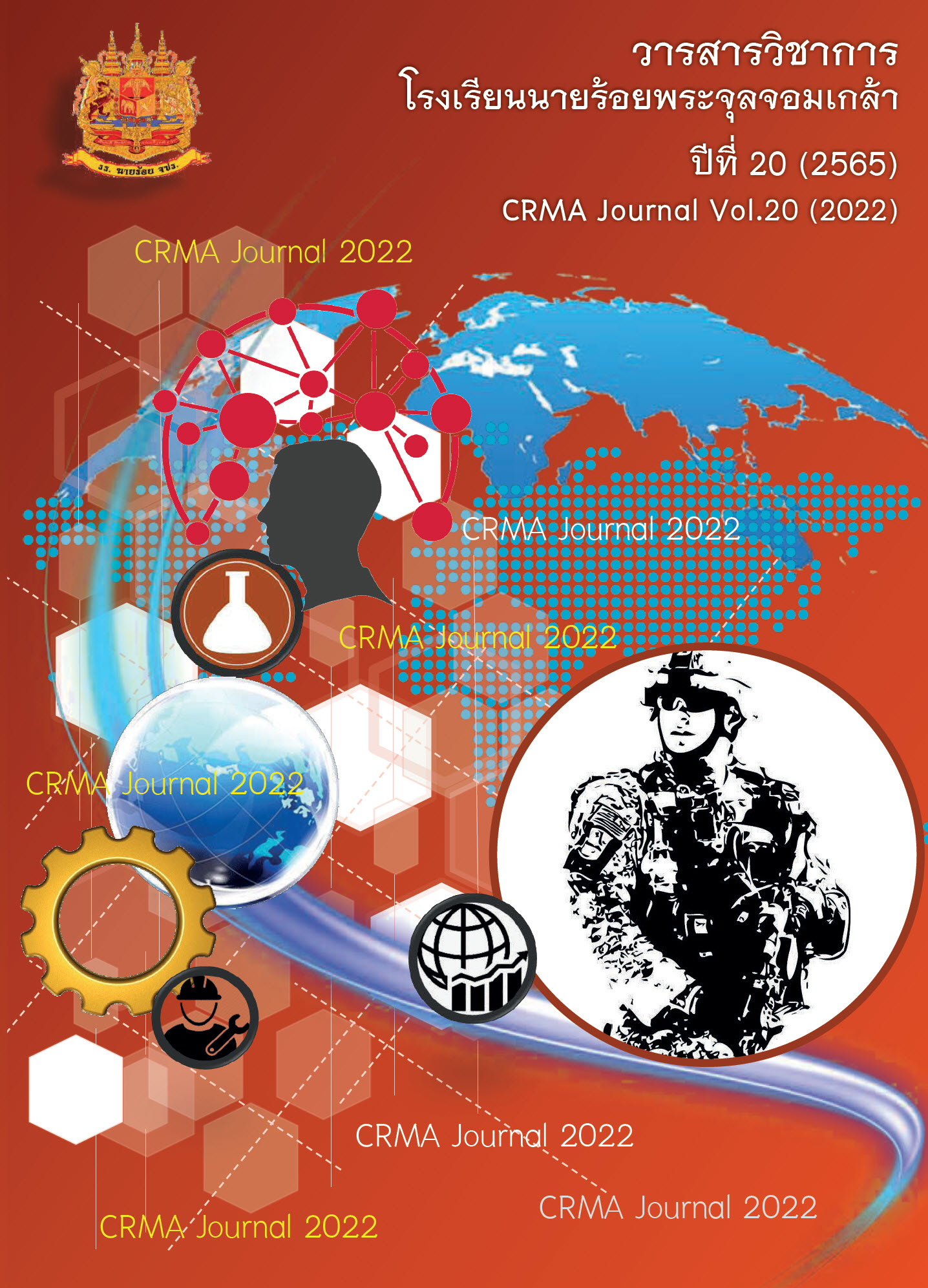การศึกษาผลของเวลาที่ใช้ในการให้แรงเชิงกลต่อสมบัติของเส้นใยนาโนเซลลูโลส
Main Article Content
บทคัดย่อ
ในการศึกษาวิจัยนี้ เส้นใยป่านศรนารายณ์ได้ถูกนำมาสกัดและลดขนาดให้เป็นเส้นใยนาโนเซลลูโลสโดยการใช้แรงเชิงกล จากนั้นทำการศึกษาและวิเคราะห์สมบัติของเส้นใยนาโนด้วยกล้องจุลทรรศน์อิเล็กตรอนแบบส่องกราดที่มีสมรรถนะสูง ชนิดฟิลด์อีมิสชัน (FE-SEM) เครื่องเอกซเรย์ดิฟแฟรกโตมิเตอร์ (XRD) ฟูเรียร์ทรานฟอร์มอินฟราเรดสเปกโตรมิเตอร์ (FTIR) และ เครื่องวัดการเปลี่ยนแปลงน้ำหนักของสารตัวอย่างเมื่อได้รับความร้อน (TGA) โดยเส้นใยนาโนเซลลูโลสสามารถเตรียมได้ผ่านการโฮโมจีไนซ์ (homogenization) แรงดันสูงอย่างต่อเนื่องเป็นเวลา 50 70 และ 90 นาที ผลการศึกษาสัณฐานวิทยา (morphology) แสดงให้เห็นถึงขนาดเส้นผ่านศูนย์กลางของเส้นใยซึ่งอยู่ในช่วง 10-30 นาโนเมตร จากผลการทดสอบพบว่าเสถียรภาพทางความร้อนของเส้นใยลดต่ำลง (281.8-272.5 องศาเซลเซียส) เมื่อให้แรงเชิงกลต่อเส้นใยในระยะเวลาที่นานขึ้น ซึ่งเป็นผลมาจากการลดลงของดัชนีความเป็นผลึก (ร้อยละ 72.3-58.5) อย่างไรก็ตามการลดลงของปริมาณผลึกจะส่งผลให้ความสามารถในการดูดซับของวัสดุเพิ่มสูงขึ้น และการทำวิจัยต่อจากนี้ก็จะนำเอานาโนเซลลูโลสไปใช้เพื่อเตรียมไฮโดรเจลที่มีความสามารถในการดูดซับ นอกจากนี้เส้นใยนาโนเซลลูโลสสามารถที่จะนำไปประยุกต์ใช้ได้ในหลายด้าน เช่น งานบรรจุภัณฑ์ การเคลือบ อุปกรณ์อิเล็คทรอนิกส์ วัสดุทางการแพทย์ และเวชสำอางค์เพื่อความงาม
Article Details

อนุญาตภายใต้เงื่อนไข Creative Commons Attribution-NonCommercial-NoDerivatives 4.0 International License.
ผลงานที่ได้รับการตีพิมพ์ ถือเป็นลิขสิทธิ์ของวารสารฯ
เอกสารอ้างอิง
H.P.A. Khalil et al., “Production and modification of nanofibrillated cellulose using various mechanical processes: a review,” Carbohydrate Polymers, vol. 99, pp. 649-65, 2014.
O. Faruk et al., “Biocomposites reinforced with natural fibers: 2000-2010,” Progress in Polymer Science, vol. 37, pp. 1552-1596, 2012.
K. Pacaphol and D. Aht-Ong, “The influences of silanes on interfacial adhesion and surface properties of nanocellulose film coating on glass and aluminum substrates,” Surface & Coatings Technology, vol. 320, pp. 70-81, 2017.
K. Pacaphol, K. Seraypheap, and D. Aht-Ong, “Development and application of nanofibrillated cellulose coating for shelf life extension of fresh-cut vegetable during postharvest storage,” Carbohydrate Polymers, vol. 224, pp. 115167, 2019.
C. Lu et al., “Reinforcement of all-cellulose nanocompositefilms using nativecellulose nanofibril,” Carbohydrate Polymers, vol. 104, pp. 143-150, 2019.
K. Uetani and H. Yano, “Nanofibrillation of wood pulp using a high-speed blender,” Biomacromolecules, vol. 12, pp. 348-353, 2011.
F. Jiang and Y.L. Hsieh, “Chemically and mechanically isolated nanocellulose and their self-assembled structures,” Carbohydrate Polymers, vol. 95, pp. 32-40, 2013.
A.F. Turbak, F.W. Snyder, and K.R. Sandberg, “Microsoft-fibrillated cellulose, a new cellulose product: properties, uses, and commercial potential,” Proceedings of the Ninth Cellulose Conference, Applied Polymer Symposia, New York, Wiley, 1983.
A.N. Nakagaito and H. Yano, “The effect of morphological changes from pulp fiber towards nano-scale fibrillated cellulose on the mechanical properties of high-strength plant fiber based composites,” Applied Physics A, vol. 78, pp. 547-552, 2004.
T. Zimmermann, E. Pöhler, and T. Geiger, “Cellulose fibrils for polymer reinforcement,” Advanced Engineering Materials, vol. 6, pp. 754-761, 2004.
L. Mathew et al., “Isolation and characterization of cellulose nanofibrils from Helicteres isora plant,” Industrial Crops and Products, vol. 59, pp. 27-34, 2014.
J. Bras et al., “Microfibrillated cellulose – its barrier properties and applications in cellulosic materials: a review,” Carbohydrate Polymers, vol. 90, pp. 735-764, 2012.
S.M. Sapuan, “Sugar palm nanofibrillated cellulose (Arenga pinnata (Wurmb.) Merr): effect of cycles on their yield, physic-chemical, morphological, and thermal behavior,” International Journal of Biological Macromolecules, vol. 123, pp. 379-388, 2019.
A. Kaushik and M. Singh, “Isolation and characterization of cellulose nanofibrils from wheat straw using steam explosion coupled with high shearhomogenization,” Carbohydrate Polymers, vol. 346, pp. 76-85, 2011.
S.M. Sapuan, “Isolation and characterization of nanocrystalline cellulose from sugar palm fibres (Arenga Pinnata),” Carbohydrate Polymers, vol. 181, pp. 1038-1051, 2018.
I. Ahmad et al., “Effect of hydrolysis conditions on the morphology, crystallinity, and thermal stability of cellulose nanocrystals extracted from kenaf bast fibers,” Cellulose, vol. 19, pp. 855-866, 2012.
P. Sukyai, “An environmentally friendly xylanase-assisted pretreatment for cellulose nanofibrils isolation from sugarcane bagasse by high-pressure homogenization,” Industrial Crops and Products, vol. 82, pp. 149-160, 2016.
S.H. Imam, “Cellulose nanowhiskers from coconut husk fibers: effect of preparation conditions on their thermal and morphological behavior,” Carbohydrate Polymers, vol. 81, pp. 83-92, 2010.
K. Pacaphol and D. Aht-Ong, “Preparation of hemp nanofibers from agricultural waste by mechanical defibrillation in water,” Journal of Cleaner Production, vol. 142, pp. 1283-1295, 2017.
F.B. Oliveira, “Production of cellulose nanocrystals from sugarcane bagasse fibers and pith,” Industrial Crops and Products, vol. 93, pp. 48-57, 2016.
I. Hongrattanavichit and D. Aht-Ong, “Nanofibrillation and characterization of sugarcane bagasse agro-waste using water-based steam explosion and high-pressure homogenization,” Journal of Cleaner Production, vol. 277, pp. 123471, 2020.


